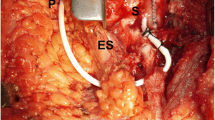Abstract
History
A 20-year-old male presented with neck pain and motor impairment of the upper extremities because of recurrent syringomyelia caused by ventriculoperitoneal shunt malfunction.
Examination and operation
A computed tomography scan after shuntgraphy demonstrated opacity in the intracranial ventricular system and cervical syrinx with contrast medium, which indicated communication between the fourth ventricle and syrinx. His symptoms resolved immediately after peritoneal catheter replacement, and magnetic resonance images obtained 1 week after surgery showed the complete resolution of hydrocephalus and syringomyelia.
Conclusion
Syringomyelia associated with ventriculoparitoneal shunt malfunction is a well-known complication in myelodysplastic patients; however, this is the first case in which communicating syringomyelia was verified with a cerebrospinal fluid dynamic study. As the present case involved communicating syringomyelia, it could only be resolved by shunt revision surgery.


Similar content being viewed by others
References
Beswick E, St. George EJ, Solanki GA (2005) Paraparesis secondary to expansion of cervical syrinx: an unusual presentation of ventriculoperitoneal shunt malfunction. Pediatr Neurosurg 41:334–336
Chowdhary A, Abel TJ, Avellino AM (2010) Ventriculoperitoneal shunt malfunction presenting as acute paraparesis in an infant. case illustration. J Neurosurg Pediatrics 5:402
Lee TT, Uribe J, Ragheb J, Morrison G, Jagid JR (1999) Unique clinical presentation of pediatric shunt malfunction. Pediatr Neurosurg 30:122–126
Martínez-Lage JF, Alarcón F, López López-Guerrero A, Felipe-Murcia M, Ruíz-Espejo Vilar A, Almagro MJ (2010) Syringomyelia with quadriparesis in CSF shunt malfunction: a case illustration. Childs Nerv Syst 26:1229–1231
Milhorat TH, Bolognese PA, Black KS, Woldenberg RF (2003) Acute syringomyelia: case report. Neurosurgery 53:1220–1222
Milhorat TH, Capocelli AL Jr, Anzil AP, Kotzen RM, Milhorat RH (1995) Pathological basis of spinal cord cavitation in syringomyelia: analysis of 105 autopsy cases. J Neurosurg 82:802–812
Milhorat TH, Johnson RW, MIhorat RH, Jr Capocelli AL, Pevsner PH (1995) Clinicopathological correlations in syringomyelia using axial magnetic resonance imaging. Neurosurgery 37:206–213
Milhorat TH, Miller JI, Johnson WD, Adler DE, Heger IM (1993) Anatomical basis of syringomyelia occurring with hindbrain lesions. Neurosurgery 32:748–754
Muthukumar N, Venkatesh G, Thiruppathy S (2005) Arrested hydrocephalus and presyrinx state: case report. J Neurosurg 103(5):466–470
Peraud A, Grau S (2009) Decompensated hydrocephalus causing syringomyelia and tetraparesis: a case report. Childs Nerv Syst 25:263–266
Disclosure
The authors declare no financial or material support. None of the work described in this study has been published elsewhere.
Author information
Authors and Affiliations
Corresponding author
Rights and permissions
About this article
Cite this article
Matsumoto, M., Takai, K. & Taniguchi, M. Communicating syringomyelia associated with ventriculoperitoneal shunt malfunction verified with a cerebrospinal fluid dynamic study: case report. Childs Nerv Syst 29, 1953–1955 (2013). https://doi.org/10.1007/s00381-013-2133-5
Received:
Accepted:
Published:
Issue Date:
DOI: https://doi.org/10.1007/s00381-013-2133-5




